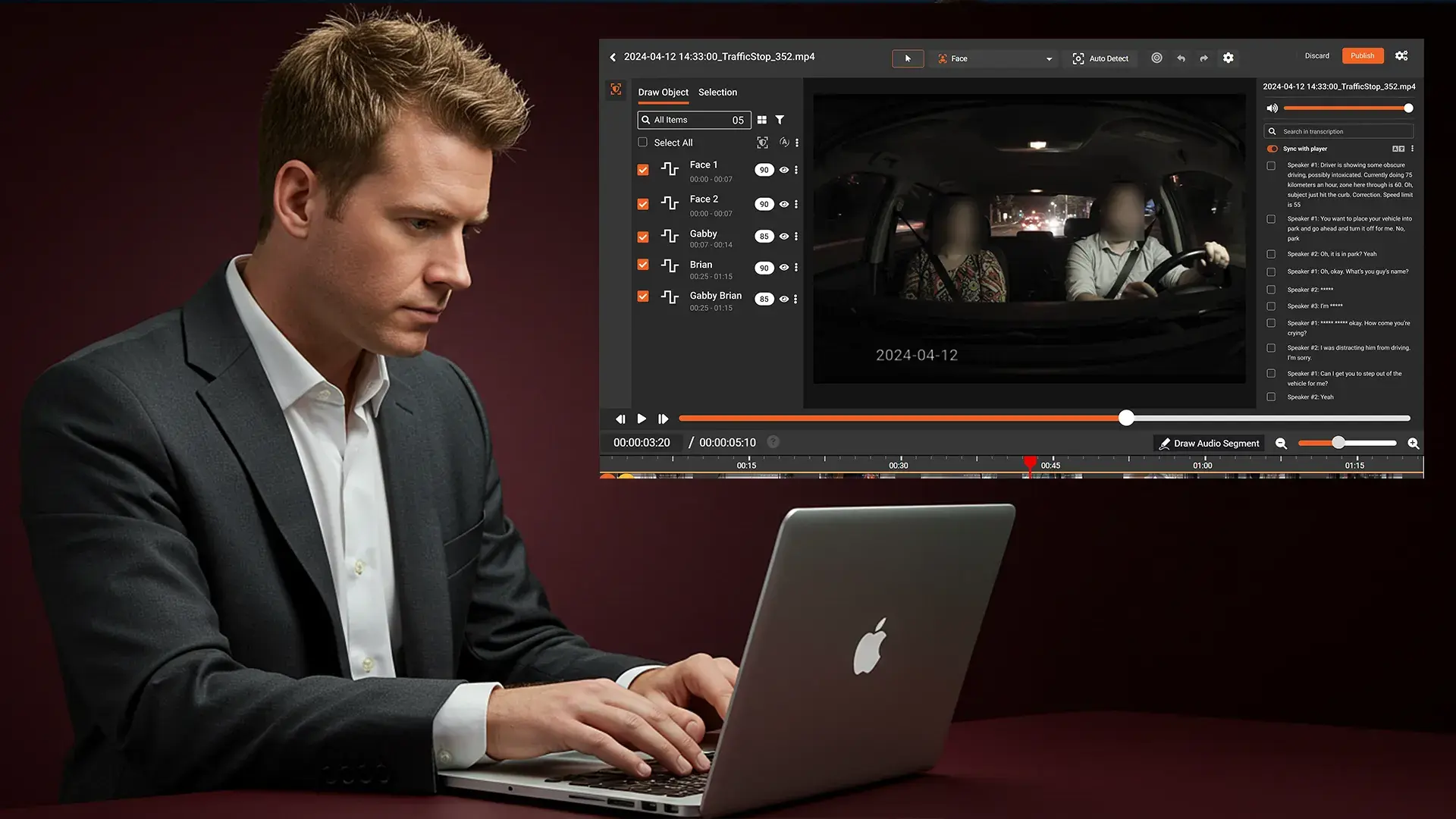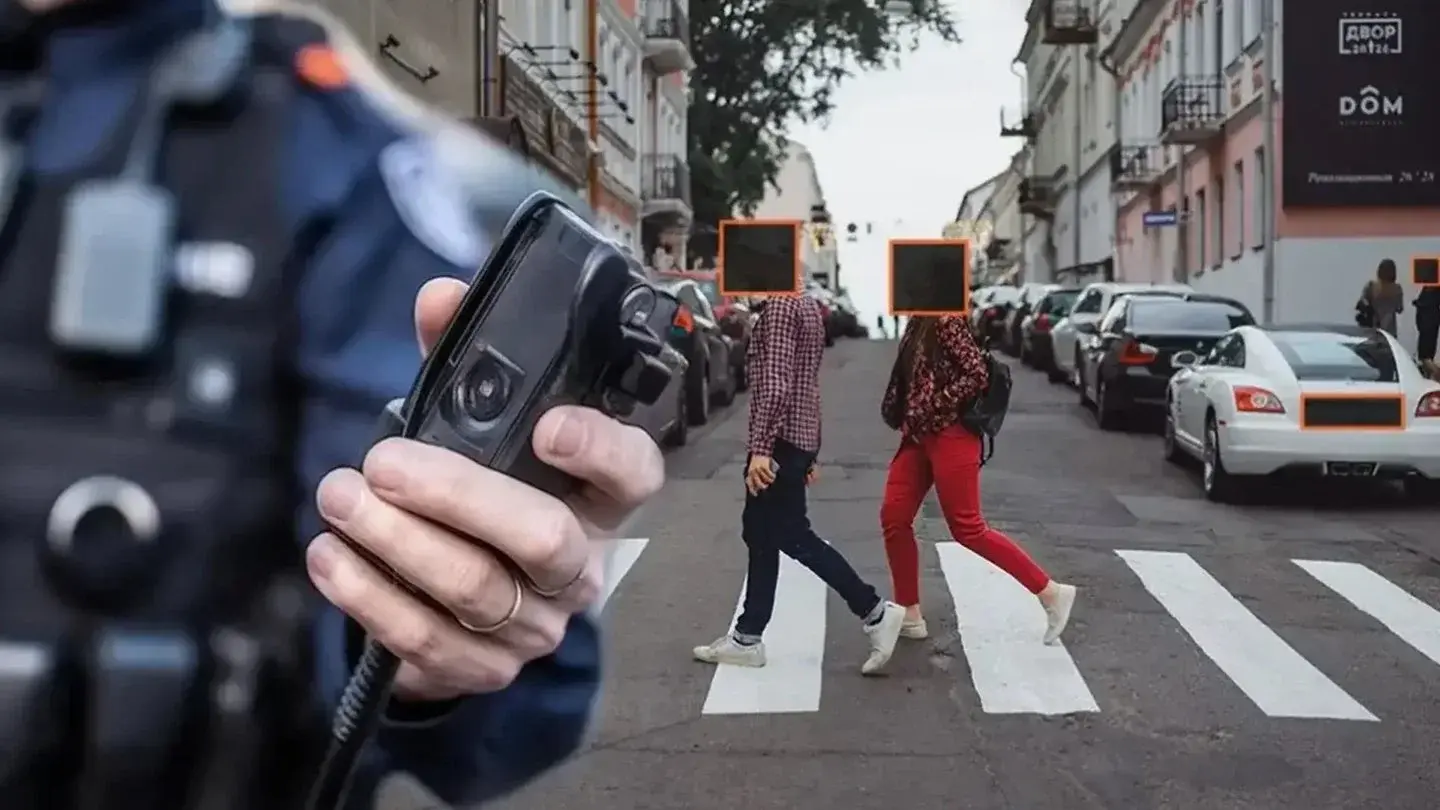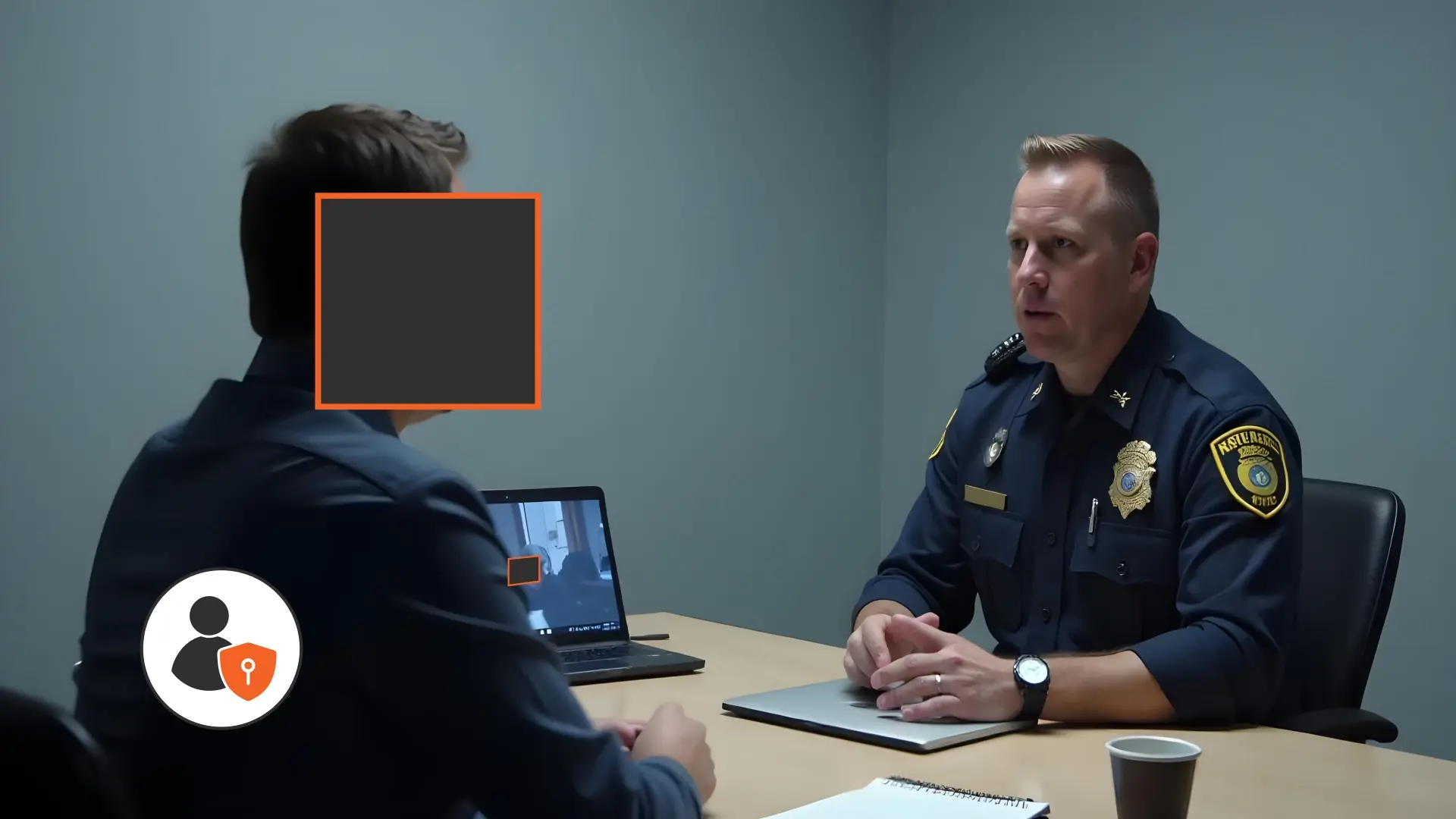Comprehensive Guide to Video Redaction Solution
by Zain Noor, Last updated: December 1, 2025

Video redaction software is becoming indispensable as organizations worldwide rely on video footage for investigations, compliance, audits, and day-to-day operations.
With privacy laws tightening and surveillance increasing, the need to protect sensitive information has never been more urgent. Whether it's a police department managing bodycam footage or a hospital handling patient videos, redaction ensures that private information stays private.
This article explores video redaction in detail, how it works, why it matters, and why choosing the right software is essential. By the end, you will also discover why VIDIZMO Redactor stands out as one of the most advanced and secure solutions available today.
Understanding Video Redaction Solution
Video redaction is the process of removing or masking identifiable information from videos. This includes faces, vehicle plates, documents, screens, and even audio. Common examples include police bodycam footage, hospital procedure recordings, retail CCTV clips, traffic surveillance videos, and corporate security camera footage where individuals or sensitive details must be anonymized before sharing.
Types of Sensitive Information Redacted
Organizations typically redact:
- Faces of individuals
- License plates
- Computer screens
- Credit card numbers
- Personal records
- Tattoos and identifiable markings
- Any visible PII/PHI
Why Advanced Redaction Is Necessary
Basic blurring is no longer enough. Modern privacy standards demand irreversible masking, accurate object tracking, and protection against data recovery. This requires intelligent AI-driven redaction tools.
Why Organizations Need Video Redaction Software
Regulatory Compliance
Organizations must comply with global privacy laws:
GDPR: Any identifiable information in videos involving EU citizens must be anonymized before sharing. For example, if a retail store captures customers’ faces in CCTV footage, those faces must be redacted before the video can be shared externally.
HIPAA: Patient faces and related PHI must be masked in healthcare recordings. For example, during the recording of a surgical procedure or a hospital room monitoring session, identifiable patient information must be redacted before the video is used for training, research, or shared externally.
FOIA: Public agencies must redact sensitive elements before releasing videos on request. For example, a police department releasing bodycam footage under a FOIA request must redact minors, victims, confidential informants, or sensitive locations before providing the video to the public.
Privacy and Security Concerns
Unauthorized exposure of individuals in videos can lead to:
- Lawsuits
- Reputational damage
- Regulatory penalties
Redaction mitigates these risks.
Industries That Depend on Video Redaction
Video redaction is no longer limited to law enforcement; it has become a core requirement across multiple sectors that handle sensitive visual data.
As video usage grows in compliance workflows, customer interactions, investigations, and operational monitoring, industries increasingly rely on automated tools to ensure privacy protection, regulatory adherence, and operational efficiency.
Organizations today face rising scrutiny around how they capture, store, and share video evidence. From hospitals to enterprise offices, video content often contains personally identifiable information (PII) and protected health information (PHI), making redaction essential before any form of public disclosure, interdepartmental sharing, or legal submission.
Why Law Enforcement Needs Video Redaction Software
Bodycams, dashcams, and interview recording software often contain civilians, minors, suspects, victims, or bystanders who must be protected before footage is released to the public, shared with the media, or submitted in court. Video Redaction Software ensures compliance with FOIA and protects sensitive identities during investigations.
Why Healthcare Needs Video Redaction Software
Patient privacy in hospital surveillance and clinical procedures. Healthcare footage may include faces, medical charts, computer screens, and other PHI that must be masked to comply with HIPAA, especially when recordings are used for training, diagnosis review, audits, or external collaborations. Video Redaction Software ensures compliance with HIPAA and protects sensitive identities during investigations.
Why Retail Needs Video Redaction Software
Shopper and employee privacy in CCTV footage. Retail environments frequently capture thousands of customers daily, and redaction is required before sharing videos for investigations, insurance claims, security audits, or public release to avoid exposing PII.
Why Insurance Needs Video Redaction Software
Scene documentation and claims investigation videos. Adjusters and investigators often capture accident scenes, damaged property, or personal environments, making redaction essential to hide unrelated individuals, license plates, addresses, or other sensitive data.
Why Corporate Enterprises Needs Video Redaction Software
Internal surveillance and compliance reviews. Companies use video for workplace monitoring, incident analysis, safety compliance, and internal investigations. Redaction ensures that employee identities and confidential information are protected during cross-departmental sharing or legal proceedings.
Why Transportation Needs Video Redaction Software
Airports, railways, and logistics companies rely on redaction for public safety compliance. Footage may capture crowds, passengers, transportation workers, or restricted areas, requiring redaction before sharing with investigators, regulatory bodies, or the public.
Key Features of Effective Video Redaction Tools
Not all redaction solutions are created equal. Modern organizations require tools that offer accuracy, speed, scalability, and the ability to adapt to different regulatory and operational environments.
Effective video redaction tools combine AI automation with manual precision controls, ensuring that even complex scenarios, such as crowded environments or fast-moving subjects, are handled with ease.
A strong video redaction solution also supports diverse media formats, seamless integrations, and flexible deployment models to meet the unique security needs of enterprises, government agencies, and healthcare institutions.
AI-Based Detection
Automatically identifying faces, plates, screens, and objects.
Object Detection & Tracking
Detect faces, people, license plates, weapons, vehicles, or custom objects across frames.
Spoken PII Redaction
Identify and remove names, addresses, SSNs, and more from audio.
Bulk Videos Redaction
Process hundreds of videos, audios, and documents in one go using automated batch workflows.
Deployment Flexibility
- Cloud
- On-premises
- Air-gapped environments
AI-Powered Redaction vs Manual Redaction
The shift from manual to AI-driven redaction represents a major leap in efficiency and accuracy. Manual redaction often requires frame-by-frame review, which is slow, inconsistent, and prone to human error.
In high-volume environments, this approach becomes impractical and delays critical workflows such as legal discovery, evidence submission, or compliance audits.
AI-powered redaction automates the detection and tracking of sensitive elements, dramatically reducing processing time while maintaining accuracy.
With machine learning algorithms that improve over time, AI systems adapt to different lighting conditions, angles, motion speeds, and scene complexities, providing reliable redaction at scale and enabling teams to focus on higher-value tasks rather than repetitive masking work.
Challenges in Video Redaction
Handling Large Video Files
High-resolution footage requires strong processing power, so organizations should evaluate their hardware capabilities or consider GPU-accelerated systems to ensure smooth processing.
In some cases, comparing on-premises high-performance hardware with cloud-based processing options can help teams choose the most efficient workflow for large video workloads.
Object Accuracy in Motion
Fast-moving subjects challenge lower-quality tools, making it important to choose solutions with advanced object tracking that can maintain accuracy during rapid movement or complex scene changes.
Processing Delays
Outdated systems may struggle with rendering, so organizations should assess their current hardware, consider upgrading to GPU-accelerated infrastructure, or compare cloud-based rendering options to ensure timely and efficient processing.
Factors to Consider When Choosing Video Redaction Software
Selecting the right video redaction solution requires balancing security, usability, performance, and budget to ensure the tool aligns with your operational and compliance needs.
Data Security
Encryption (such as AES-256), role-based access controls, secure authentication, and detailed audit logs are essential. Tools that meet certifications like GDPR, CJIS, or HIPAA provide additional assurance, especially for regulated industries.
Processing Speed
Faster systems reduce bottlenecks by accelerating video processing tasks, minimizing wait times for large files, and ensuring uninterrupted workflows, especially important for teams handling high‑volume or time‑sensitive redaction workloads.
Ease of Use
A user-friendly interface should require minimal training. Look for intuitive timelines, drag‑and‑drop workflows, automated detection toggles, and clear preview tools that simplify the redaction process for both technical and non‑technical staff.
Integration
Redaction tools should integrate smoothly with Content Management Systems (CMS), Digital Evidence Management Systems (DEMS), and Records Management Systems (RMS), or evidence management platforms. Poor integration often leads to workflow bottlenecks, duplicated work, or compatibility issues, so native APIs or prebuilt connectors are valuable.
Pricing
Choose a model that fits your operational scale. Common options include subscription-based pricing, per‑user licensing, per‑video processing, or enterprise packages. Compare expected volume and long‑term needs to avoid cost overruns.
Cloud vs On-Premises Solutions
Choosing the right deployment model is essential, as it directly impacts data security, scalability, compliance, and overall operational efficiency.
Cloud Solution
Great for scalability, ease of deployment, and reduced infrastructure management. Cloud deployments also minimize the need for in-house IT maintenance, offer automatic updates, and allow organizations to quickly adapt to changing storage or processing demands.
On-Premises
Ideal for high-security agencies with strict data governance, and often mandatory in environments where data cannot leave the organization’s infrastructures as defense, intelligence, certain healthcare institutions, and government bodies with classified information requirements.
What a Reliable Redaction Tool Should Offer
Real-Time Redaction
Live redaction during active recordings, enabling organizations to automatically mask faces, license plates, screens, and other sensitive identifiers in real time as the video is being captured ideal for law enforcement, public safety operations, and high-security environments where instant privacy protection is required.
Multimodal AI
Unified redaction across video, audio, images, and documents in one workflow. Sensitive information can be detected and masked consistently across every format without switching tools. VIDIZMO Redactor makes multimodal redaction simple, fast, and reliable, giving organizations an easy way to protect all types of content with one powerful solution.
Advanced Automation
AI automation boosts accuracy while cutting down on manual work. It quickly detects patterns, fixes tracking issues, and adapts to different scenarios on its own. The result is faster, more consistent, with minimal human effort, helping teams manage large workloads with ease. These capabilities aren’t futuristic; they’re already built into today’s leading solutions, like VIDIZMO Redactor
Why VIDIZMO Redactor Is the Right Solution for Your Video Redaction Needs
As organizations deal with growing privacy responsibilities, choosing the right redaction system is critical. VIDIZMO Redactor is designed specifically for enterprises, government agencies, healthcare institutions, and law enforcement teams that need reliable, compliant, and automated redaction.
VIDIZMO Redactor goes beyond simple masking. It leverages AI to detect faces, bodies, plates, screens, documents, and audio identifiers, ensuring complete protection of PII/PHI. With high accuracy, flexible deployments, and enterprise-grade security, it is one of the most advanced redaction tools on the market.
What Sets VIDIZMO Redactor Apart?
- Automated AI-based detection
- Redaction for video, images, and audio
- Compliance with GDPR, HIPAA, FERPA, FOIA, and global regulations
- On-prem, cloud, and air-gapped options
- End-to-end encryption and strict security controls
- Scalable performance for large video workloads
- API integration with existing systems
VIDIZMO Redactor is built for organizations that cannot afford mistakes.
Experience VIDIZMO Redactor for Yourself
VIDIZMO Redactor gives your team the accuracy, speed, and security they need to stay compliant and operationally efficient.
Explore our Video Redaction Solution Capabilities
OR
Book a Free Trial - No Credit Card Needed
Jump to
You May Also Like
These Related Stories

Safeguarding Privacy in Law Enforcement with Body Camera Redaction

Why Redacting Software Matters for Your Business Success in 2025



No Comments Yet
Let us know what you think